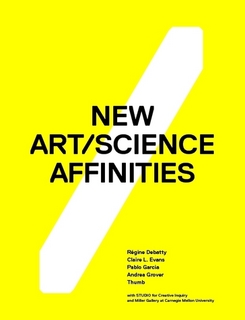Grover, Debatty, Evans, Garcia, Thumb: New Art/Science Affinites (2011)
Filed under sprint book | Tags: · art, bio art, biotechnology, hacking, maker culture, media art, programming, science, subversion, technology

The Miller Gallery at Carnegie Mellon University and the STUDIO for Creative Inquiry have co-published “New Art/Science Affinities,” a 190-page book on contemporary artists that was written and designed in one week by four authors (Andrea Grover, Régine Debatty, Claire Evans and Pablo Garcia) and two designers (Luke Bulman and Jessica Young of Thumb).
“New Art/Science Affinities,” which focuses on artists working at the intersection of art, science and technology, was produced by a collaborative authoring process known as a “book sprint.” Derived from “code sprinting,” a method in which software developers gather in a single room to work intensely on an open source project for a certain period of time, the term book sprint describes the quick, collective writing of a topical book.
The book includes meditations, interviews, diagrams, letters and manifestos on maker culture, hacking, artist research, distributed creativity, and technological and speculative design. Chapters include Program Art or Be Programmed, Subvert! Citizen Science, Artists in White Coats and Latex Gloves, The Maker Moment and The Overview Effect.
Sixty international artists and art collaboratives are featured, including Agnes Meyer-Brandis, Atelier Van Lieshout, Brandon Ballengée, Free Art and Technology (F.A.T.), Rafael Lozano-Hemmer, The Institute for Figuring, Aaron Koblin, Machine Project, Openframeworks, C.E.B. Reas, Philip Ross, Tomás Saraceno, SymbioticA, Jer Thorp, and Marius Watz.
The authors collectively wrote and designed the book during seven, 10-14 hour-days in February 2011 at the STUDIO for Creative Inquiry. During their sessions they held conversations with CMU faculty, staff and students from the STUDIO, Miller Gallery, College of Fine Arts, Robotics Institute, Machine Learning Department and BXA Intercollege Degree Program.
“The book sprint method was adopted in order to understand this very moment in art, science and technology hybrid practices, and to mirror the ways Internet culture and networked communication have accelerated creative collaborations, expanded methodologies, and given artists greater agency to work fluidly across disciplines,” says lead author Andrea Grover.
The publication is part of Grover’s Andy Warhol Foundation for the Visual Arts Curatorial Research Fellowship at CMU’s STUDIO for Creative Inquiry and Miller Gallery. “Intimate Science,” an exhibition that will be the product of Grover’s research, will take place in early 2012 at the Miller Gallery.
Published by Miller Gallery at Carnegie Mellon University + CMU STUDIO for Creative Inquiry, October 2011
ISBN 0977205347
190 pages
Licensed under Creative Commons Attribution-NonCommercial-NoDerivs 3.0 License
commentary (We-Make-Money-Not-Art.com)
authors
Jussi Parikka: Insect Media: An Archaeology of Animals and Technology (2010)
Filed under book | Tags: · animal, biopolitics, biopower, biotechnology, cybernetics, deterritorialization, entomology, ethology, game theory, immanence, media archeology, media ecology, ontology, perception, philosophy, posthumanism, swarm intelligence, technology

“Since the early nineteenth century, when entomologists first popularized the unique biological and behavioral characteristics of insects, technological innovators and theorists have proposed insects as templates for a wide range of technologies. In Insect Media, Jussi Parikka analyzes how insect forms of social organization—swarms, hives, webs, and distributed intelligence—have been used to structure modern media technologies and the network society, providing a radical new perspective on the interconnection of biology and technology.
Through close engagement with the pioneering work of insect ethologists, including Jakob von Uexküll and Karl von Frisch, posthumanist philosophers, media theorists, and contemporary filmmakers and artists, Parikka develops an insect theory of media, one that conceptualizes modern media as more than the products of individual human actors, social interests, or technological determinants. They are, rather, profoundly nonhuman phenomena that both draw on and mimic the alien lifeworlds of insects.
Deftly moving from the life sciences to digital technology, from popular culture to avant-garde art and architecture, and from philosophy to cybernetics and game theory, Parikka provides innovative conceptual tools for exploring the phenomena of network society and culture. Challenging anthropocentric approaches to contemporary science and culture, Insect Media reveals the possibilities that insects and other nonhuman animals offer for rethinking media, the conflation of biology and technology, and our understanding of, and interaction with, contemporary digital culture.”
Publisher University of Minnesota Press, 2010
Posthumanities Series 11
ISBN 0816667403, 9780816667406
320 pages
Review: Jennifer Gabrys (Mute).
PDF (updated on 2012-7-15)
Comment (0)Michal Šimonfy: Bio – Art (2011) [Slovak]
Filed under thesis | Tags: · bio art, bioethics, biotechnology, genetics, nature, simulation, wetware

Diplomová práca mapuje rôzne umelecké prístupy, ktoré si za oblasť svojho záujmu zvolili skúmanie živej prírody, predovšetkým s prihliadnutím na jej vnútornú, biologickú či genetickú podstatu. Samostatnú časť práce tvoria príklady umeleckých stratégií spájajúce umenie, vedu a biotechnológie, pričom problematike genetického výskumu a vyvstávajúceho nového vzťahu medzi človekom, prírodou a technológiami je venovaná druhá kapitola práce, dôrazom na ich možné spoločenské, etické či politické dôsledky.
Diplomová práca
Akadémia umení v Banskej Bystrici, Fakulta výtvarných umení, Katedra Intermédií a digitálnych médií
Vedúci práce: MgA. Michal Murin ArtD.
Školiteľ: PhDr. Katarína Rusnáková, Ph.D.
Banská Bystrica: FVU AKU 2011
68 strán
viac (vrátane informácií o praktickej časti práce)
Comment (0)
